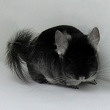Lufenuron: Potential Promise for Chinchilla Applications?
|
This week on the auction, we are offering one of the first five 18K Yellow Gold Chinchilla Millennia pendants to be cast and sold to the public. This piece is No. 4 in the Limited Edition Series. Don't miss this opportunity to own one of the first 18K Yellow Gold CM IV miniature sculptures. |
|
|
Next week we will be listing only the second and last Black Velvet Royal Persian Angora to be sold in 2007. To see this listing, please visit the Chinchillas.com Auction between June 27th and July 4th. |
Lufenuron: Potential Promise for Chinchilla Applications?
One of the most common problems for domestic chinchilla breeders is the control and containment of skin fungus. Finding a minimally toxic and effective treatment for chinchilla fungus would be a great asset for any chinchilla breeder. Five of the most common treatments for skin fungus are Desenex, Clotrimazole, Fulvicin, Betadine, and Captan 50. Desenex and Clotrimazole are easy to obtain, relatively inexpensive, and easy to administer. However, many times they are not completely effective at eradicating skin fungus. Fulvicin requires a prescription from a vet, is more expensive, and can potentially cause liver damage, although it is an effective systemic medication. Betadine is readily available, easy to administer, and safer to use. Although it will stain the coat, it tends to be an effective treatment in all but the most severely afflicted animals. Captan 50 is a plant fungicide that works extremely well, but it can also be very dangerous for both the chinchilla and the people exposed to it. I don't recommend its use on chinchillas for this reason. Of the five treatments mentioned, only Fulvicin treats systemic infections. The other treatments are only used to treat afflicted areas topically.
After a considerable amount of research two years ago into the best and safest way to treat a young mare with fungal endometritis (fungal infection of the uterus), it was suggested by my equine practitioner that I learn more about the drug lufenuron. It is sold under the brand name Program to treat dogs and cats for fleas. Although to the best of my knowledge it is not FDA approved for equine use at this time, it is used experimentally in the equine industry to treat equine fungal endometritis. When used on mares, it is not given orally, but infused directly into the uterus of the mare.
Lufenuron is a benzoylphenyl urea (BPU) derivative and is classified as an insect development inhibitor that prevents the synthesis, polymerization, or deposition if chitin.2 Fungal organisms are surrounded by chitin-rich cell walls, and it is speculated that disruption of this cell wall inhibits fungal growth. Because BPU derivatives affect chitin production, they are thought to be safe for use in mammals as mammalian cells lack chitin.
Lufenuron is used most commonly as a once-a-month treatment to provide flea control for dogs and cats .3 Following oral administration, lufenuron accumulates in adipose tissue and is slowly released in the blood over time.4 It has also been effective for treatment of dermatomycoses in dogs and cats.4 On the basis of results of these reports, it was considered to be a reasonable, minimally toxic alternative to standard anti-fungal management of fungal endometritis.1
We are unaware of any current research or information pertaining to the use of lufenuron in the chinchilla, and we are not recommending it be used without proper approval by the FDA and your veterinarian, but this might be an interesting and potentially important medication for the chinchilla breeding and veterinary research communities to look into for treating skin fungus in the chinchilla.
References
1. Hess MB, Parker NA, Purswell BJ, Dascanio JD. Use of lufenuron as a treatment for fungal endometritis in four mares. JAVMA, Vol 221, No. 2, July 15, 2002; 266-267.
2. Cohen E. Interference with chitin biosynthesis in insects. In: Wright JE, Retnakaran A, eds. Chitin and benzolphenyl ureas. Dordrecht, The Netherlands: Dr. W. Junk, 1987; 43-73.
3. Hink WF, Drought DC, Barnett S. Effect of an experimental systemic compound, CGA-184699, on life stages of the cat flea ( Siphonaptera: Pulicidae ). J Med Entomol 1991;28:424-427.
4. Ben-Ziony Y, Arzi B. Use of lurenuron for treating fungal infections of dogs and cats: 297 cases (1997-1999). J Am Vet Med Assoc 2000;217:1510-1513.
Notice:
Your personal preferences are set to receive newsletters
and surveys from chinchillas.com. To modify your personal preferences
and unsubscribe, go to http://www.chinchillas.com/personal
and log in to your personal account, select View/edit your personal information
then change "participate in survey" to no and "on mailing
list" to no.
Copyright© 2007 Chinchillas.com All rights reserved. Designated trademarks and brands are the property of their respective owners.


